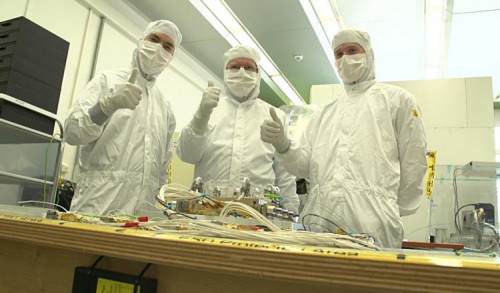A SATELLITE with a Glasgow-built heart which will help detect ripples in the fabric of universe is set for blast-off in 2015.
The LISA Pathfinder satellite will test technology which will detect gravitational waves – ripples in space and time which are caused by massively violent events in space such as the collision of black holes and the explosion of dying stars.
The optical bench, the heart of the satellite built by Glasgow University, has now been fixed in place in the satellite ahead of its launch by the European Space Agency (ESA).

Scientists have been trying for years to detect gravitational waves, which were first predicted by Albert Einstein, but they cannot be measured on Earth.
If they are detected they could change the way we understand physics and gravity.
The overall cost of the satellite, which has been designed by several nations and NASA, is thought to be more than £340milllion.
Dr Christian Killow, Scottish Universities Physics Alliance Advanced Fellow at the University, said: “With the optical bench now in place, we have reached an important milestone.
“The sophisticated laser interferometer performs superbly and is ready for its job in space. We are really excited that the LISA Pathfinder mission is now well positioned for launch in 2015.”
LISA Pathfinder will test the technology on a smaller scale ahead of a full mission to detect gravitational waves.
The satellite’s “inteferometer” is 40cm long, but a full-scale one will need to stretch millions of kilometers across space.
Bench
It is now in Astrium, a space industry firm, in Germany and firmly on course for a launch in 2015, the university says.
At Astrium members of the Glasgow team performed health checks on the optical bench photodiodes which turn the laser beams into electrical signals.
The scientists also measured micron-level measurement of the beam positions on the photodiodes – which shows the optical bench survived the trip to Germany undamaged.
The staellite must survive forces of up to 35 times the gravitational acceleration on Earth during its rocket launch, and still be properly aligned at a minute level.
In order to build the optical bench the Glasgow scientists, led by Dr. Harry Ward, developed a inventing a super strong and super sensitive silicate bonding material, which can be used like an advanced super glue to position parts of the satellite in place.
The “glue” could find new uses for other spacecrath as well as industry on Earth, the University says.